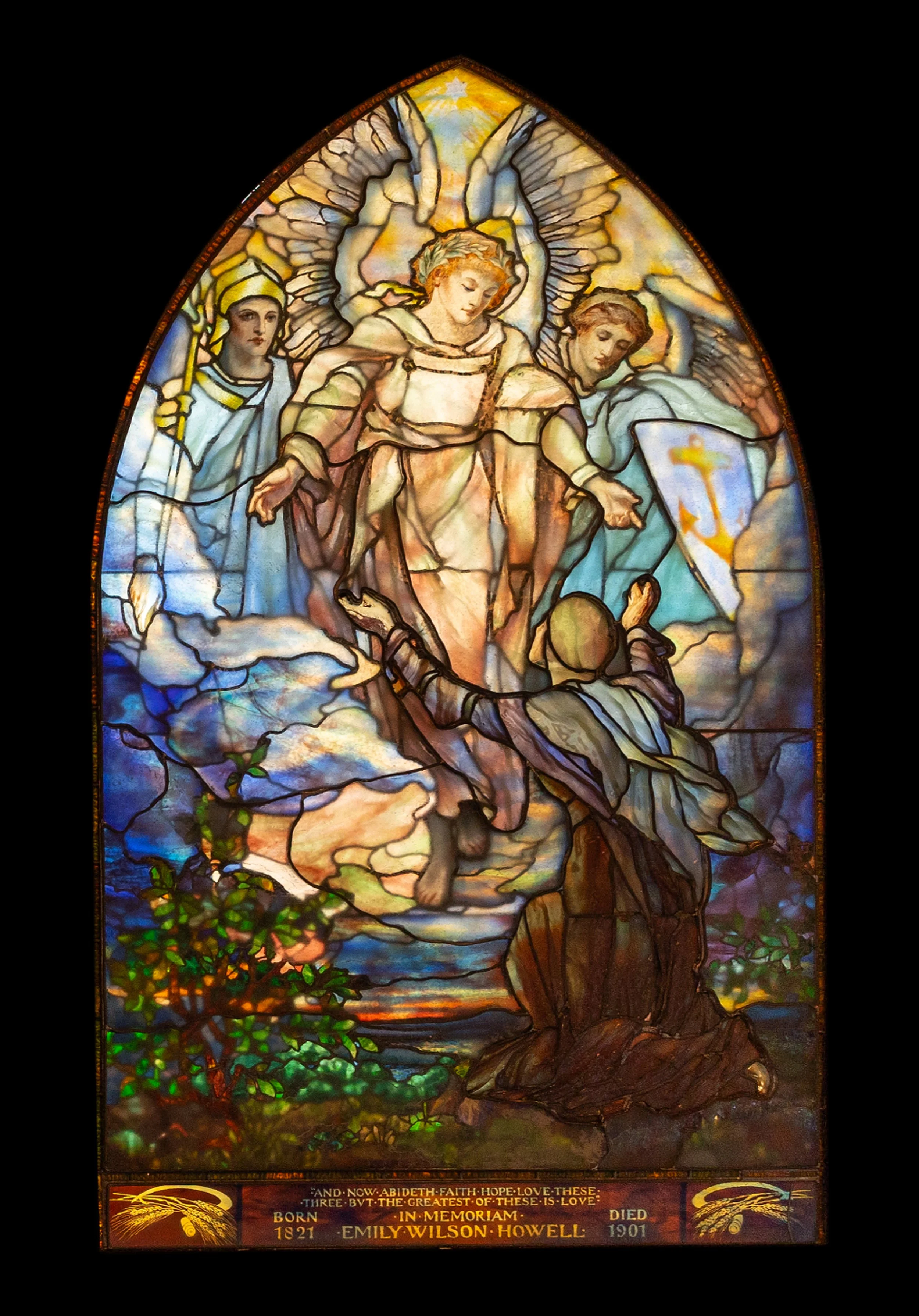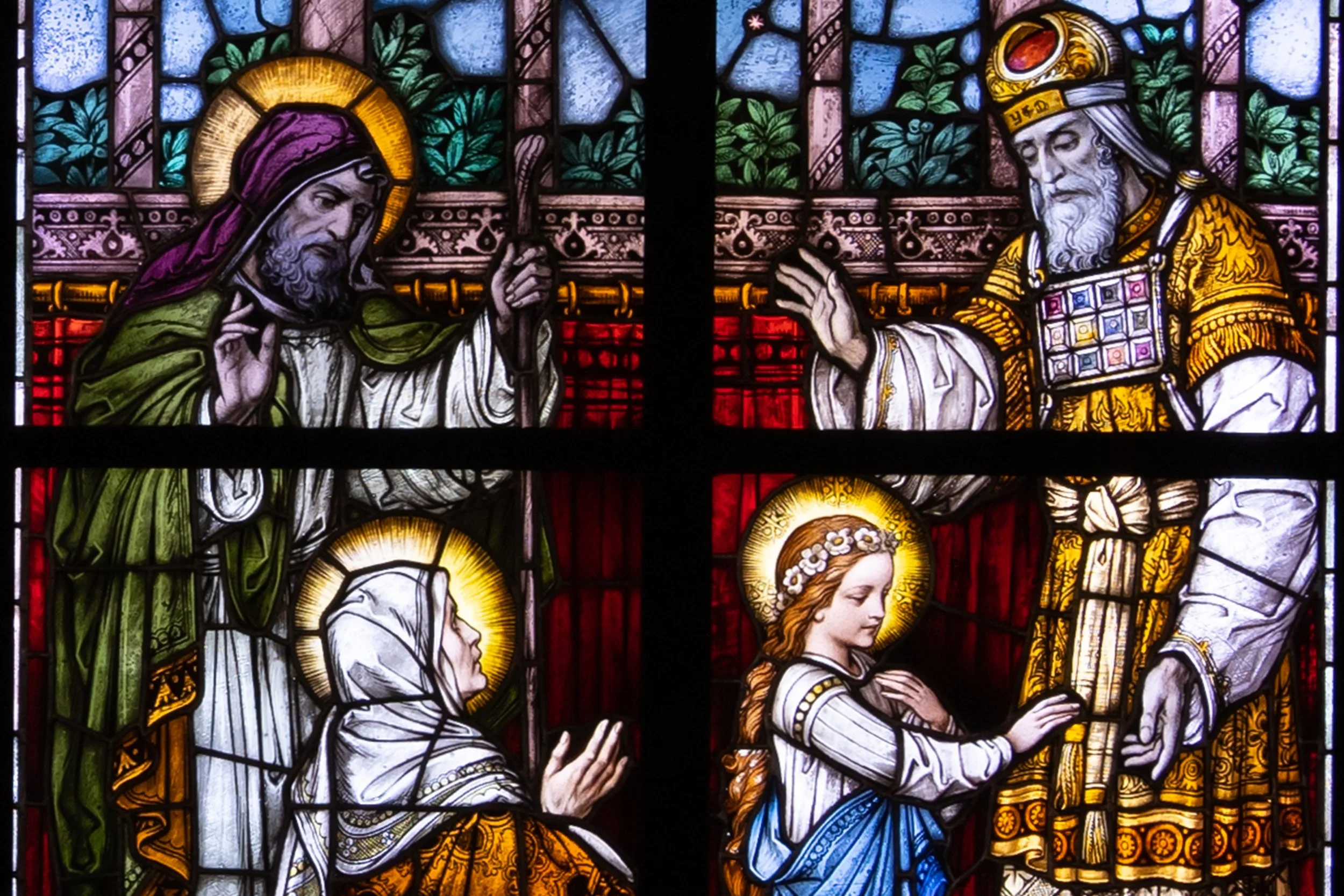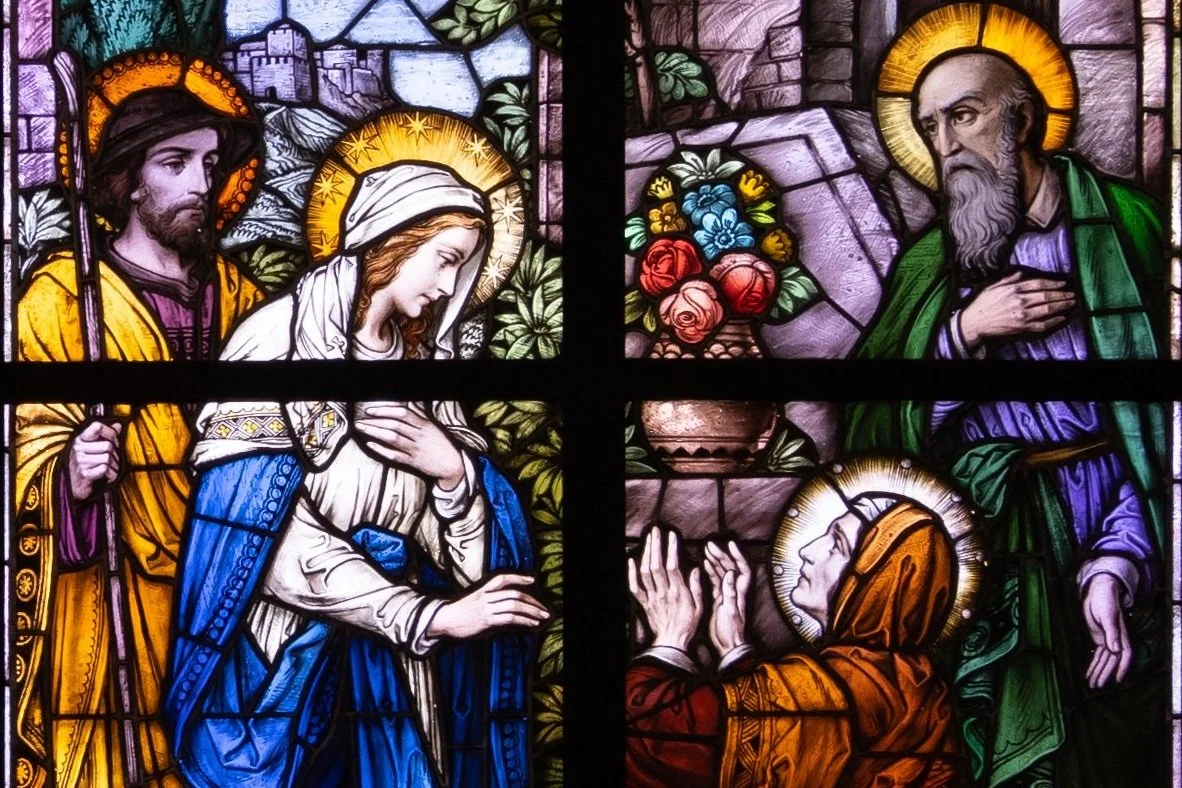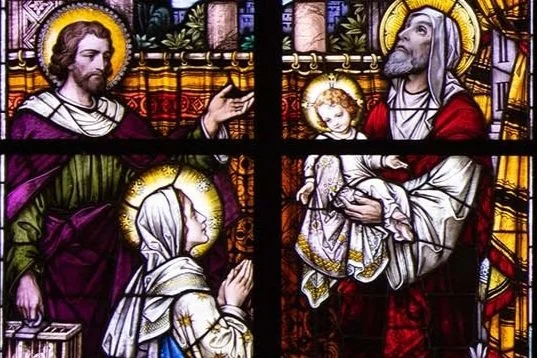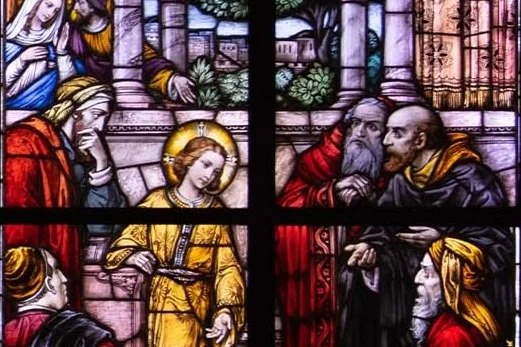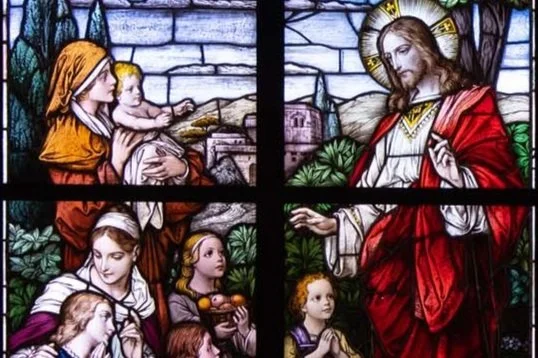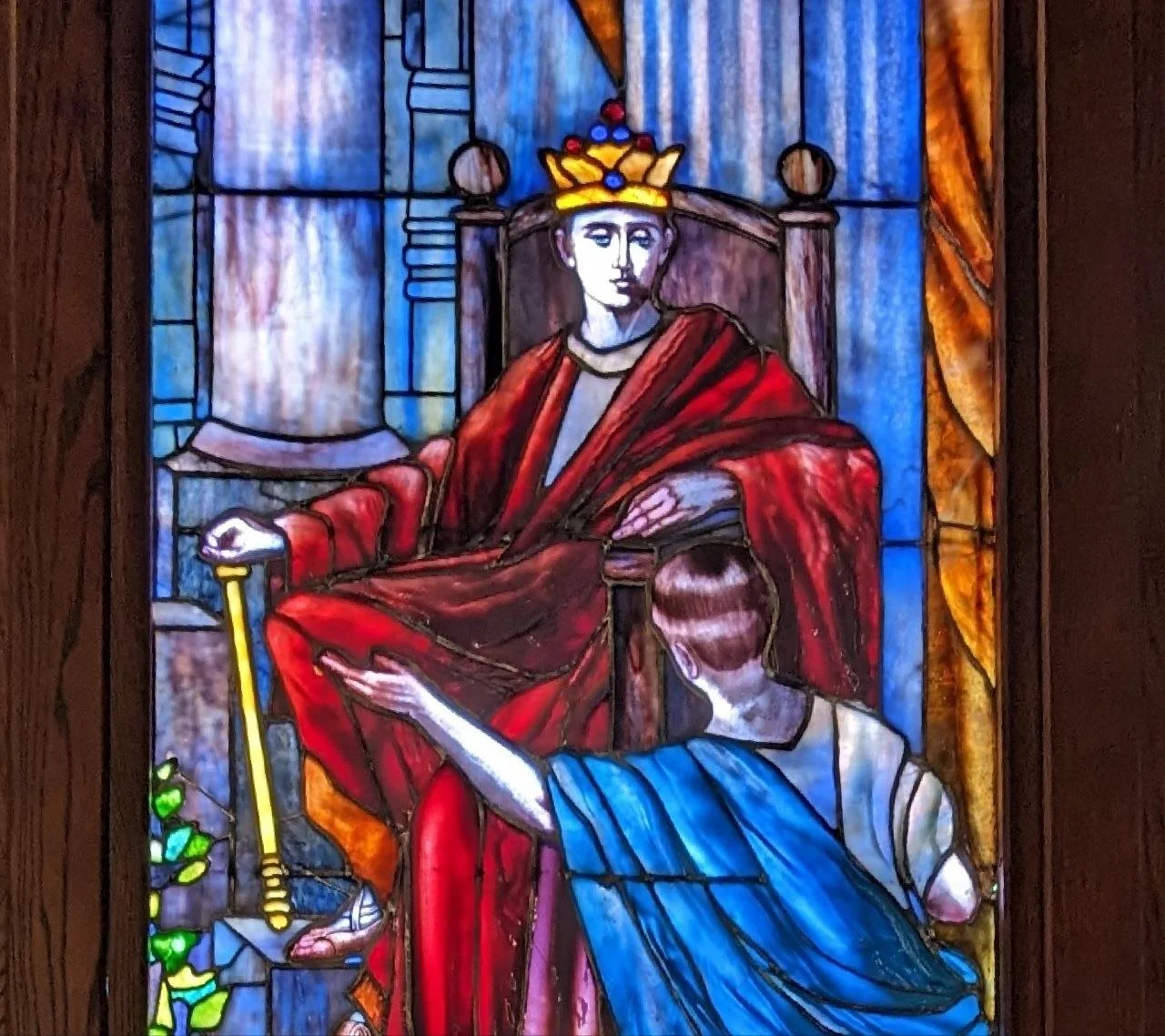Works of Art in the Nave Area
Artist: Tiffany Studios (1848-1943)
Title: The Ascension
Date: 1906
Medium: Opalescent & favrile Glass
Style: American Art Nouveau
102” x 102”
The Ascension
#12
Jesus gracefully ascends into heaven before the viewer, welcomed into heaven by a crowd of angels. In Christian tradition, Jesus was crucified by Roman soldiers. He was placed in a tomb where he lay dead for three days until he was resurrected and ascended to heaven to be with his Father. The resurrection and ascension of Jesus is a highly celebrated story, repeated in a multitude of artworks and stained glass windows.
Artist: Tiffany Studios (1848-1943)
Title: The Vision of Virtues
Date: 1902
Medium: Opalescent & favrile Glass
Style: American Art Nouveau
92 (7/8)” x 58 (1/8)”
The Vision of Virtues
#13
Inscribed into the glass is the Bible verse of 1 Corinthians 13:13: "and now abideth faith, hope, love, these three; and the greatest of these is love." The three virtues may be symbolically seen here as the three angels that descend onto a worshiper to deliver their divine messages. The middle angel appears larger and wears a laurel wreath, an emblem of victory, showing that love is the virtue that should triumph over all.
Artist: Tiffany Studios (1848-1943)
Title: St. John the Divine of Patmos
Date: 1902
Medium: Opalescent & favrile Glass
Style: American Art Nouveau
93” x 58 (1/4)”
St. John the Divine of Patmos
#14
Saint John is known as the author of the book of Revelations and had been exiled to the Greek island of Patmos due to anti-Christian persecution by the Roman Empire. He had powerful visions about the seven churches and the Last Days. The window quote is Revelations 1:18: Jesus says, "I am he that liveth, and was dead; and, behold, I am alive, and forever more." Jesus stands before John, holding a sphere with seven stars that symbolize the seven churches from the visions.
Artist: Tiffany Studios (1848-1943)
Title: King Solomon Instructing the Youth
Date: 1902
Medium: Opalescent & favrile Glass
Style: American Art Nouveau
93 (1/8)” x 58 (1/8)”
King Solomon Instructing the Youth
#15
King Solomon is a Biblical character who is said to have ruled over ancient Judah from approximately 970-931 BCE. He was known as a wise king who descended into sin and incurred the wrath of God. The window inscription is a verse written by Solomon in Ecclesiastes 12:13: "Let us hear the conclusion of the whole matter: fear God, and keep his commandments: for this is the whole duty of man." The book of Ecclesiastes was written as divine teachings to worshipers, and in this window, Solomon is depicted lecturing the book contents to the youth.
Angel
Medium: Marble
15” x 46 (1/2)” x 14”
Angel
Statue #2
Artist: Franz Mayer and Co.
Title: Jesus Heals the Dead
Date: N/A
Medium: Painted Glass
Style: Munich Mayer
149 (1/2)” x 57”
Jesus Heals the Dead
#16
During his travels, Jesus happened upon a funeral in the town of Nain. A widowed mother was escorting her deceased son for his funerary procession, followed by a large crowd. It was here that Jesus performed a miracle and revived the deceased, shocking the entire crowd and the mother, who reached out for her son in longing. The crowd praised God and spread the news of Jesus's deed throughout the kingdom of Judea. The verse quoted is Luke 7:14, where Jesus tells the deceased son, "Young man, I say to you, get up!"
Artist: Franz Mayer and Co.
Title: The Garden of Gethsemane
Date: N/A
Medium: Painted Glass
Style: Munich Mayer
148 (3/4)” x 56 (1/2)”
The Garden of Gethsemane
#17
In the garden of Gethsemane, Jesus kneels in prayer in front of a godsent angel who takes his cup. The disciples sleep soundly in the background, unaware of the divine interaction. This window tells the story of Jesus praying several times in Gethsemane while his disciples were sitting and watching over him. The window quotes Matthew 26:42: "Jesus went away a second time and prayed, 'My Father if it is not possible for this cup to be taken away unless I drink it, may your will be done.'"
Artist: Franz Mayer (1848–1926)
Title: Young Mary in the Temple
Date: ca. 1870
Medium: Painted Glass
Style: Munich Mayer
161” x 55 (1/2)”
Young Mary in the Temple
#18
The Holy Mary is presented by her parents at the Temple of Jerusalem and is welcomed by the priests and clergy. Her mother Anna kneels at the altar while her father Joachim stands, gazing down at Mary. The presentation of Mary is described in the Protoevangelium of James (The Gospel of James), a document from 145 A.D. that details all of Mary's life.
Artist: Franz Mayer and Co.
Title: The Annunciation
Date: ca. 1880
Medium: Painted Glass
Style: Munich Mayer
155 (7/8)” x 50”
The Annunciation
#19
The foretelling and birth of Jesus is a popular theme in Christian artwork. The story can be found in the Bible, in Luke 1:26-45, where Mary is visited by the angel Gabriel in Nazareth, telling her that she will be blessed to birth the son of God. The dove above Mary is the Holy Spirit that was said to bless her with the ability to conceive a child.
Artist: Franz Mayer and Co.
Title: The Visitation
Date: ca. 1880
Medium: Painted Glass
Style: Munich Mayer
161 (1/8)” x 55 (1/4)”
The Visitation
#20
The pregnant Mary visits the home of her cousin Elizabeth and her husband Zechariah, who had been blessed by God, too. The couple were elderly and had been hoping to have a child regardless. Their prayer had been answered by an angel and Elizabeth became pregnant at her old age. When Mary came to visit them, Elizabeth's body was filled with the Holy Spirit and she knew immediately that Mary was pregnant with the son of God, excitedly yelling that Mary was incredibly blessed.
Artist: Franz Mayer and Co.
Title: The Nativity
Date: ca. 1880
Medium: Painted Glass
Style: Munich Mayer
160 (7/8)” x 55 (1/2)”
The Nativity
#21
The Virgin Mary, Joseph, and shepherds all gaze in wonder at the baby Jesus. In the Bible, Luke 2:8, the shepherds were guarding their herds near Bethlehem when an angel appeared before them and told the shepherds: "A Savior has been born to you; he is the Messiah, the Lord." The shepherds found Jesus and praised God, leaving to spread the word the angel had given them.
Artist: Franz Mayer and Co.
Title: The Presentation of Jesus in the Temple
Date: c. 1880
Medium: Painted Glass
Style: Munich Mayer
164" x 58"
Presentation of Jesus in the Temple
#22
St. Rose of Viterbo
Medium: Marble
11” x 51 (3/4)” x 9 (1/4)”
St. Rose of Viterbo
Statue #3
Artist: Franz Mayer and Co.
The Finding in the Temple
Date: ca. 1880
Medium: Painted Glass
Style: Munich Mayer
160 (3/4)” x 55 (3/4)”
The Finding in the Temple
#23
Artist: Franz Mayer and Co.
Title: The Wedding Feast of Cana
Date: ca. 1880
Medium: Painted Glass
Style: Munich Mayer
161”x 55 (1/2)”
The Wedding Feast of Cana
#24
Jesus, his mother Mary, and his disciples were all invited to a wedding in Cana. When the hosts ran out of wine, Mary asked Jesus to produce more wine. Jesus had the servants pour water into large stone jars and then instructed them to serve it. The water turned into wine, and only the servants knew who was responsible for this miracle, while the hosts of the party were unaware that the wine was water in the first place.
Artist: Franz Mayer and Co.
Title: Jesus with Children
Date: ca. 1880
Medium: Painted Glass
Style: Munich Mayer
161 (1/8)” x 55 (1/2)”
Jesus with Children
#25
Artist: Franz Mayer and Co.
Title: Delivery of the Keys to the Kingdom of Heaven
Date: ca. 1880
Medium: Painted Glass
Style: Munich Mayer
161” x 55 (1/2)”
Delivery of the Keys to the Kingdom of Heaven
#26
Jesus and his disciples were in the region of Caesarea Philippi when Jesus asked them, "Who do people say is the Son of Man? ...And who do you say I am?" Simon Peter, one of the disciples, answered that Jesus was the actual Messiah. To this, Jesus responds that he will give him the keys to the kingdom of heaven. In the scene, Simon Peter is kneeling before Jesus as he proclaims that Jesus is the true son of God. The lambs are a representation of Jesus and of his purity and sacrifice.
Artist: Franz Mayer and Co.
Title: The Agony in the Garden
Date: ca. 1880
Medium: Painted Glass
Style: Munich Mayer
164 (3/4)” x 55 (1/2)”
The Agony in the Garden
#27
St. Anne
Medium: Marble
20” x 54” x 13 (1/4)”
St. Anne
Statue #4
Artist: Franz Mayer (1848–1926)
Title: The Crucifixion
Date: ca. 1870
Medium: Painted Glass
Style: Munich Mayer
156 (1/4)” x 49 (1/2)”
The Crucifixion
#28
Jesus Christ was sentenced to death by crucifixion by the Roman governor Pontius Pilate because Jesus claimed to be the son of God. Crucifixion was a punishment enacted by the Roman Empire on specific criminals such as disgraced soldiers and Christians. At the crucifixion, Jesus was observed by many who loved him, including his mother. Jesus told his mother to take his disciple John as a son so that they could take care of each other.
Artist: Franz Mayer and Co.
Title: The Resurrection
Date: ca. 1880
Medium: Painted Glass
Style: Munich Mayer
160 (5/8)” x 55 (1/2)”
The Resurrection
#29
Artist: Franz Mayer (1848–1926)
Title: Coronation of the Blessed Virgin
Date: ca. 1870
Medium: Painted Glass
Style: Munich Mayer
156” x 49 (1/2)”
Coronation of the Blessed Virgin
#30
Artist: Franz Mayer and Co.
Title: St. Boniface & Thor’s Oak
Date: ca. 1880
Medium: Painted Glass
Style: Munich Mayer
162” x 55 (1/2)”
St. Boniface & Thor’s Oak
#31
Saint Boniface (c.675-754) was an English monk who was best known for his role in converting the Germanic people of the kingdom of Francia (modern-day France, Germany, and Italy). This scene depicts the story where Boniface struck down the pagans' sacred oak tree. A group of pagans watched him cut it down and feared that their gods would kill Boniface, but when nothing happened, they were convinced they were wrong about their religion. With the oak logs, Boniface would build a Christian church.
Artist: Unknown
Title: King Tyrus and Ezekiel
Date: N/A
Medium: Stained Glass
Style: American Art Nouveau
71 (7/8)” x 30 (3/4)”
King Tyrus and Ezekiel
#32
The prophet Ezekiel is the protagonist of the Book of Ezekiel, where we find the prophecy against the King of Tyre (Tyrus in Latin). Ezekiel revealed many visions that were recorded in the Christian scriptures, talking mostly about judgments and blessings for nations and the people of God. Here, Ezekiel is portrayed as delivering his prophecy to the king of Tyrus, telling him that the arrogant king would fall from power. It is theorized among some Christians that the prophecy against the king of Tyrus was an allegory, a story with a hidden meaning that claimed that the king was Lucifer. This theory comes from Ezekiel 28, where there are references to the angel Lucifer's fall from heaven.


